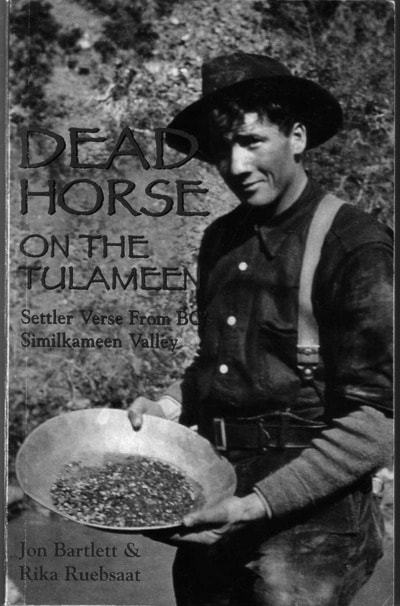Jon Bartlett and Rika Rubesaat’s recent book release, Dead Horse on the Tulameen presents us with a perspective of Similkameen valley history that is uniquely local and untainted by external opinion and perspective.
The book describes the history of the valley through submitted verse and poetry researched from local newspapers over the last 100 years.
Dead Horse on the Tulameen describes the settlement of the Similkameen, the development of the local resource and agricultural industry, through both world wars, outlining local history by way of the lyrical submissions that were made to the various newspapers of the day.
This approach to local history gives the reader an interesting angle from which to understand the thinking of the people of the day, as nothing needs to be interpreted. It is a history that is pure, for back in the days when it was popular to write to local newspapers this way, the Similkameen valley was very isolated, with poor, indirect transportation routes and limited communication to places outside the valley.
Bartlett and Ruebsaat also discuss the idea of “boosterism,” and the effect it had on the development of the small communities of the valley.
Through the use of old time verse, we find that history continues to repeat itseslf - the problems of the business sector in small communities in the old days are not much different from today’s - as we read in a verse called “Buy at Home,” a poem appearing in the Hedley Gazette in 1915, where the poet writes:
“Other folks buy by mail, buy at home.
Help the home store to a sale, buy at home.
Every dollar sent away means a dollar less to pay,
What is owed right here today - buy at home.”
Bartlett and Rubesaat also note the importance of the press in the early days of communication, and its importance in getting news and advertising to the populace. The profession was not lost on the public of the day either, as they responded with such poems as “Ode to the Gazoot,” “The Newspaper Guy,” and “Twinkle, Twinkle Little Star,” a poem about the Similkameen Star written in the Coalmont Courier in July of 1922.
Other chapters are devoted to such topics as sports, transportation routes to the coast, and the automobile age. In the latter chapter, the reader is once again amused by the fact that little has changed in attitude over the years about the way automobiles work. In the poem “The Village Motorsmith” the writer describes a backyard mechanic motorist who spends much time and effort trying to figure out why his car won’t run, only to find out he is out of gas. Other poems (“The Frisky Fords,” “The Joy Rider” and “The Wife”) refer to the seeming inherent stupidity of many drivers, a sentiment many of us can still relate to.
Bartlett and Rubesaat’s commentary on social development in the Similkameen valley is also interesting, in that many of us don’t realize how isolated people in the valley were before the automobile and modern roads and communications - as a result, locals had to create their own forms of entertainment, and writing poetry for the local newspaper to describe or comment on daily life in the valley was one way to do this.
They also point out that the predominant sentiment in the valley followed British ideals, because that was the majority of the settler population - which meant that most of what was printed in the paper was generally agreed upon by everyone in the valley.
The final chapter deals with the book’s namesake - “Dead horse on the Tulameen” - completing this writing by explaining how this one song, or poem, caught the valley’s imagination in such a way that it became part of the local psyche, something that was remembered by generations, becoming the stuff of folklore and legend.
Dead Horse on the Tulameen provides the reader with a unique way of understanding the history about the Similkameen, providing the reader with a new perspective on local history.
The book also has an interesting way of taking historical events occurring outside the valley and relating to the reader their effect on the daily life of the Similkameen valley resident.The reader is able to get a much more localized sense of how people felt about the times they lived in.
Dead Horse on the Tulameen: Settler Verse from BC’s Similkameen Valley
Authored by Jon Bartlett and Rika Ruebsaat, Published by the Canadian Folk Workshop in Princeton, 293 pages
- Copies are available at Pharmasave and the Infocentre in Keremeos, at Hooked on Books and the Dragon’s Den in Penticton, at the Visitors’ Centre, the Penticton Museum, the Sunflower Gallery and six other places in Princeton and at Mosaic Books in Kelowna.
The book can also be ordeed online at:
jonandrika.org
Bartlett and Ruebsaat will be doing a presentation in Kelowna sponsored by the Okanagan Institute at the Bohemian Cafe in Kelowna on Dec.1 at 5 p.m.
